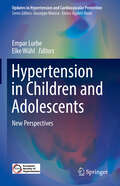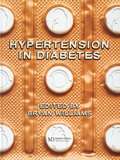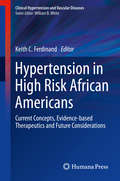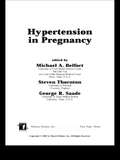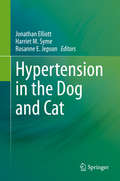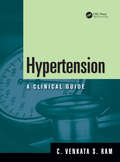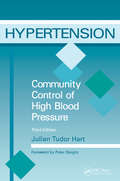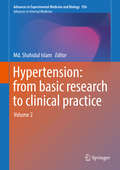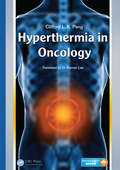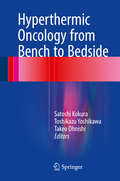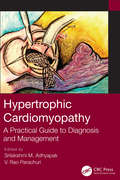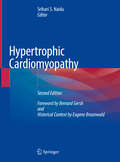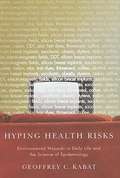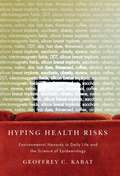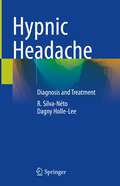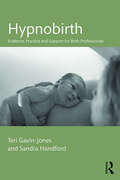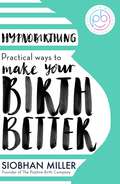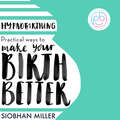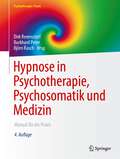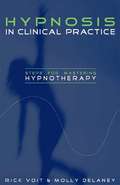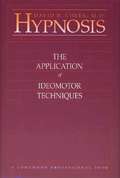- Table View
- List View
Hypertension in Children and Adolescents: New Perspectives (Updates in Hypertension and Cardiovascular Protection)
by Empar Lurbe Elke WühlThis book is devoted to hypertension in children and adolescents, a clinical issue that – thanks to the strides made in several areas of pathophysiological and clinical research – has received growing interest in cardiovascular medicine over the last several years. Given the increasing prevalence of hypertension in children and adolescents, this book represents an important and useful tool to address what has become a significant public health issue. It covers a diverse range of topics, from advances in the definition of hypertension and the identification of new risk factors, to current treatment strategies. The book also presents an overview of the latest findings, including the clinical significance of isolated systolic hypertension (ISH) in youth, the importance of out-of-office and central blood pressure measurement, new methods for assessing vascular phenotypes, and clustering of CV risk factors. Gathering contributions by international experts and pursuing a practice-oriented approach, the book offers a valuable tool for cardiologists, pediatricians and nephrologists, as well as general practitioners.
Hypertension in Diabetes
by Bryan WilliamsDiabetes mellitus, particularly non-insulin-dependent diabetes Type 2, is a common disease and, even though insulin has been around for seventy years, this endocrine disorder still reduces the life expectancy of diabetic patients because of the development of long-term complications, including hypertension. Hypertension occurs twice as often in dia
Hypertension in High Risk African Americans
by Keith C. FerdinandThis volume discusses the many ways to prevent, identify and control hypertension in African Americans, a common and potent risk factor for virtually all forms of cardiovascular-renal diseases. Comprehensive chapters address modifiable risk factors, such as lifestyle changes, especially sodium restriction, and appropriate combination pharmacotherapy. Emerging devices and evidence-based approaches that may also enhance effective blood pressure control and decrease the disparate cardiovascular disease risks, including MI, stroke, HF, and cardiorenal metabolic syndrome and diabetes are also discussed in detail. Written by a wide-range of experts in the field, Hypertension in High Risk African Americans: Current Concepts, Evidence-based Therapeutics and Future Considerations is a valuable resource for clinicians, researchers, health administrators and public health policy leaders to better understand the best practices and unique aspects of risk assessment and treatment of hypertension and co-morbid conditions in African Americans.
Hypertension in Pregnancy
by George R. Saade Michael A. Belfort Steven ThorntonCovers gestational and chronic hypertension in addition to severe preeclampsia, eclampsia, and HELLP syndrome and discusses the interaction with the renal, hematological, neurological, and hepatic systems of pregnant women.
Hypertension in the Dog and Cat
by Jonathan Elliott Harriet M. Syme Rosanne E. JepsonThis book provides an in-depth review on various aspects of canine and feline hypertension. Physiology, pathophysiology, epidemiology and pathological consequences of high blood pressure in cats and dogs are discussed. A comparative approach is taken, the underpinning research is critically evaluated and knowledge gaps identified. In addition, the reader is presented with evidence-based treatment strategies. The book targets researchers, graduate students and clinical specialists in small animal internal medicine as well as veterinary clinicians with interest in nephrology, cardiology, neurology and ophthalmology.
Hypertension: A Clinical Guide
by C. Venkata RamHypertension has become a major public health hazard not only in industrialized nations, but also in emerging economies. Early detection combined with effective treatment is imperative to reduce the risk of patients developing premature cardiovascular disease and accelerated atherosclerosis. A clear, concise resource, Hypertension: A Clinical Guide
Hypertension: Community Control of High Blood Pressure, Third Edition
by Hart Julian TudorFully updated and revised Differential Diagnosis in Dermatology Third Edition now includes sections on treatment as well as serving as a useful guide to dermatological diagnosis in the surgery or clinic. It takes the reader through the process of diagnosing skin disease from the basic biology of skin history taking describing skin lesions and carrying out special investigations. This book provides excellent clinical photography practical text and clear diagrams throughout. Chapters are divided into different body areas and possible diagnosis can be made by reading through the text or looking through the photographs.
Hypertension: from basic research to clinical practice
by Md. Shahidul IslamHypertension: from basic research to clinical practice” contains a unique collection of selected chapters written by experts and enthusiasts engaged in research and treatment of hypertension, a condition that affects around a billion people in the world. The chapters describe fundamental researches at cellular and molecular levels to the science, and art of treatment of the condition in clinical practice. The topics included ranges from pathophysiology of hypertension, through monitoring of hypertension, to the treatment of hypertension in different patient categories. It contains essential background information as well as cutting edge research, and state of the art treatment alternatives in this broad field. From the beginners, and research students to the expert clinicians, and established scientists, everybody has something to learn from this book.
Hyperthermia in Oncology
by Clifford PangHyperthermia in oncology is the application of heat to a patient's body for the purpose of cancer treatment. In recent years, its use has seen rapid development, with a large amount of clinical data becoming available. Hyperthermia in Oncology synthesizes the current research on the topic and provides treatment protocols for using localized as well
Hyperthermic Oncology from Bench to Bedside
by Satoshi Kokura Toshikazu Yoshikawa Takeo OhnishiThis comprehensive work broadens readers' understanding of the rudimentary mechanism of the anti-cancer effect of hyperthermia. It also presents state-of-the-art clinical outcomes by hyperthermia treatment of cancer. In the past few decades, basic and clinical research have shown through in vitro experiments that hyperthermia inhibits epithelial-mesenchymal transition (EMT), resulting in the prevention of metastasis. It also has been learned that hyperthermia shows its superior benefit when applied in combination with radiation therapy, chemotherapy, or various immunotherapies as treatments of several types of carcinoma. The chapters here from expert contributors describe the details of their research for each type of cancer. This book provides not only an overview and the current status of hyperthermia but also its future perspectives. Therefore this volume will greatly benefit oncologists, radiologists and radiology technologists, and chemotherapists who are involved in immunotherapy for all kinds of cancer.
Hypertrophic Cardiomyopathy: A Practical Guide to Diagnosis and Management
by Srilakshmi M. Adhyapak V. Rao ParachuriHypertrophic cardiomyopathy is a disease of the cardiac muscle leading to severe debilitating symptoms with relentless progression. Medical options in treating this disease are limited to its early stages, with the disease often becoming resistant to pharmacological interventions. Hypertrophic Cardiomyopathy: A Practical Guide to Diagnosis and Management describes the various sub-types of this condition, including its unique anatomic features, with an emphasis on a therapeutic approach, encapsulating several techniques. Surgical myectomy has become the gold standard of effective treatment. This book also throws light on patient selection, newer surgical techniques, and novel image-based pre-operative planning modalities for surgical myectomy. Key Features Explores the surgical aspects along with the clinical coverage of hypertrophic cardiomyopathy Provides ready resource for practicing cardiologists, practitioners, trainees, and fellows Covers anatomical variants, mitral valve pathology, and non-invasive pre-surgical planning with a detailed surgical video and intra-operative pictures
Hypertrophic Cardiomyopathy: Foreword By Bernard Gersh And Historical Context By Eugene Braunwald
by Srihari S. NaiduThis extensively updated edition provides a comprehensive review of hypertrophic cardiomyopathy, the most common genetic disorder of the heart characterized by dysfunctional contractility at the sarcomere level. The disease produces abnormal and oftentimes focal hypertrophy on a macroscopic level that further impairs cardiac performance and may lead to life-threatening arrhythmias. This edition provides a practical approach, establishing evidence-based best practice for all scenarios.Hypertrophic Cardiomyopathy provides readers with key points and critical clinical pearls to assist them in managing patients. New chapters have been included on managing hypertension, sleep apnea, coronary artery disease, structural and congenital disease, nutrition and pharmacotherapies. All aspects of treatment are covered – medications, pacemakers and defibrillators, and invasive septal reduction therapy (both surgical myectomy and alcohol septal ablation) – in addition to genetics, family screening, lifestyle concerns, and athletic screening. The practical approach has been reinforced with an expanded emphasis on creating a Center of Excellence, how to facilitate the multi-disciplinary approach, and on case-based reviews and discussions, with each chapter ending with a post-test.This book is an essential text for cardiology professionals from trainee to board-certified physician, and includes important information for interventional cardiologists, cardiac surgeons, cardiac imagers, critical care physicians, sports medicine physicians, genetic counsellors, and electrophysiologists.
Hyping Health Risks: Environmental Hazards in Daily Life and the Science of Epidemiology
by Geoffrey C. KabatAccording to author and epidemiologist Geoffrey C. Kabat, this hyping of low-level environmental hazards leads to needless anxiety and confusion on the part of the public as to which exposures have important effects on health.
Hyping Health Risks: Environmental Hazards in Daily Life and the Science of Epidemiology
by Geoffrey KabatThe media constantly bombard us with news of health hazards lurking in our everyday lives, but many of these hazards turn out to have been greatly overblown. According to author and epidemiologist Geoffrey C. Kabat, this hyping of low-level environmental hazards leads to needless anxiety and confusion on the part of the public concerning which exposures have important effects on health and which are likely to have minimal or no effect. Kabat approaches health scares as "social facts" and shows that a variety of factors can contribute to the inflating of a hazard. These include skewed reporting by the media, but also, surprisingly, the actions of researchers who may emphasize certain findings while ignoring others; regulatory and health agencies eager to show their responsiveness to the health concerns of the public; and politicians and advocates with a stake in a particular outcome. By means of four case studies, Kabat demonstrates how a powerful confluence of interests can lead to overstating or distorting the scientific evidence. He considers the health risks of pollutants such as DDT as a cause of breast cancer, electromagnetic fields from power lines, radon within residences, and secondhand tobacco smoke. Tracing the trajectory of each of these hazards from its initial emergence to the present, Kabat shows how publication of more rigorous studies and critical assessments ultimately help put hazards in perspective.
Hypnic Headache: Diagnosis and Treatment
by R. Silva-Néto Dagny Holle-LeeHypnic headache is a rare primary headache that occurs only during sleep with a prevalence of 0.07%. Diagnosis are challenging since patients do not show changes in neurological examinations or exams. This book covers essential topics on clinical aspects of hypnic headache, complemented by differential diagnosis, pathophysiology and treatment. It is based on all reports and case series on hypnic headache that have been described to date, totaling 348 cases. It also brings up-to-date information besides to the diagnostic criteria described in the International Classification of Headache Disorders (ICHD-3). Written by authors with decades of experience, it’s divided into eleven chapters presenting the Historical aspects, Headaches classification, Epidemiology, Clinical characteristics in adults and children, Pathophysiology, Differential diagnosis, and Treatment. Hypnic Headache - Diagnosis and Treatment will be important not only for headache specialists, neurologists, but also for students and clinical physicians.
Hypno-Skripte: Lebensverändernde Methoden durch Selbsthypnose und Meditation
by Mary DealEntfessle die Kraft deines Geistes und entdecke dein Potenzial! Wünschst du dir, du hättest die Macht, alles zu werden, was du sein kannst? Jede gut gemeinte Programmierung funktioniert am besten, wenn du tiefere Ebenen des Bewusstseins erreichst. Das Geheimnis besteht darin, diese Ebenen durch einfache, lebensverändernde Techniken zu erschließen. Ein dünner Hauch des Bewusstseins unterscheidet zwei Geisteszustände: Selbsthypnose und Meditation. Dieses Buch erklärt ihre Ähnlichkeiten und beschreibt ihre jeweiligen Verhältnisse und deren Zugänglichkeit. Bist du neugierig genug, in dieses Buch zu blättern, so ist die Fähigkeit, diese Methoden zu lernen, bereits ein Teil deines Bewusstseins, der sich bald erkennen lassen wird. Glücklicher Mensch! Dein Unterbewusstsein fordert dich zur Forschung auf. Es sagt, dass du tiefere Geisteszustände erreichen kannst. Viele haben schon versucht, Selbsthypnose oder Meditation zu lernen, sind aber gescheitert. Eine geleitete, angewandte Konzentration oder das Wissen, was zu erwarten war, wenn sie einmal in Trance sind, haben möglicherweise gefehlt. Dieses Buch ist für diejenigen gedacht, die die Techniken der Selbsthypnose und/oder der Meditation zur Selbstverbesserung erlernen und anwenden möchten. Einfache, doch leistungsstarke Skripte werden angeboten, mit denen in beiden Techniken gearbeitet werden kann, um erwünschte Veränderungen zu bewirken. Du kannst dein Leben heute verändern!
Hypnobirth: Evidence, practice and support for birth professionals
by Teri Gavin-Jones Sandra HandfordMaternity services and choices for labour and birth are fast evolving. Hypnobirth involves preparation for childbirth using tried and tested hypnotherapy techniques in harmony with midwifery best practices and increasing numbers of women are turning to the technique. Written by two experienced practitioners, this is the first evidence-based practice book for medical professionals on this subject. Chapters include coverage of: What hypnosis is and the history of hypnobirth The power of the mind and the effect of language Relaxation and breathing techniques The neocortex and hormones Birth partners, relationships, women’s advocates and primary supporters Throughout the book the authors provide health professionals working in clinical midwifery practice with information and evidence-based findings to support the use of hypnobirth. The book includes case studies, scripts and reflective questions to encourage a deeper understanding of the techniques and issues and to engage and inspire the reader. Hypnobirth is essential reading for midwives, obstetricians, student midwives, doulas and any practitioner involved in preparing and supporting pregnant women for labour.
Hypnobirthing: Practical Ways to Make Your Birth Better
by Siobhan MillerTHIS BOOK WILL MAKE YOUR BIRTH BETTER. IT IS FOR EVERY WOMAN AND EVERY TYPE OF BIRTH. 'Siobhan manages to completely demystify hypnobirthing, making it accessible and relevant to all women and all births. This book will be a complete game changer and I will be recommending it to mums-to-be from now on' Sarah Turner, author of The Unmumsy MumExpert hypnobirthing teacher and founder of The Positive Birth Company Siobhan Miller has made it her mission to change the way women around the world approach and experience birth. Through her teaching she seeks to educate and empower women - and their birth partners - so that they can enjoy amazing and positive birth experiences, however they choose to bring their babies into the world.In this book, Siobhan debunks common myths about hypnobirthing and explains why she believes it can make every type of birth a better experience - from a water birth at home to an unplanned caesarean in theatre.So, what is hypnobirthing? Essentially, it's a form of antenatal education, an approach to birth that is both evidence-based and logical. Hypnobirthing certainly doesn't involve being hypnotised; instead, it teaches you how your body works on a muscular and hormonal level when in labour and how you can use various relaxation techniques to ensure you are working with your body (rather than against it), making birth more efficient and comfortable.Siobhan's advice and guidance will change your mindset and enable you to navigate your birth with practical tools that ensure you feel calm and in control throughout.By the time you finish this book you'll feel relaxed, capable and genuinely excited about giving birth.
Hypnobirthing: Practical Ways to Make Your Birth Better
by Siobhan MillerTHIS BOOK WILL MAKE YOUR BIRTH BETTER. IT IS FOR EVERY WOMAN AND EVERY TYPE OF BIRTH.AS FEATURED ON DRAGONS' DEN. 'Siobhan manages to completely demystify hypnobirthing, making it accessible and relevant to all women and all births. This book will be a complete game changer and I will be recommending it to mums-to-be from now on' Sarah Turner, author of The Unmumsy MumExpert hypnobirthing teacher and founder of The Positive Birth Company Siobhan Miller has made it her mission to change the way women around the world approach and experience birth. Through her teaching she seeks to educate and empower women - and their birth partners - so that they can enjoy amazing and positive birth experiences, however they choose to bring their babies into the world.In this book, Siobhan debunks common myths about hypnobirthing and explains why she believes it can make every type of birth a better experience - from a water birth at home to an unplanned caesarean in theatre.So, what is hypnobirthing? Essentially, it's a form of antenatal education, an approach to birth that is both evidence-based and logical. Hypnobirthing certainly doesn't involve being hypnotised; instead, it teaches you how your body works on a muscular and hormonal level when in labour and how you can use various relaxation techniques to ensure you are working with your body (rather than against it), making birth more efficient and comfortable.Siobhan's advice and guidance will change your mindset and enable you to navigate your birth with practical tools that ensure you feel calm and in control throughout.By the time you finish this book you'll feel relaxed, capable and genuinely excited about giving birth.
Hypnobirthing: Practical Ways to Make Your Birth Better
by Siobhan MillerTHIS BOOK WILL MAKE YOUR BIRTH BETTER. IT IS FOR EVERY WOMAN AND EVERY TYPE OF BIRTH.AS FEATURED ON DRAGONS' DEN. 'Siobhan manages to completely demystify hypnobirthing, making it accessible and relevant to all women and all births. This book will be a complete game changer and I will be recommending it to mums-to-be from now on' Sarah Turner, author of The Unmumsy MumExpert hypnobirthing teacher and founder of The Positive Birth Company Siobhan Miller has made it her mission to change the way women around the world approach and experience birth. Through her teaching she seeks to educate and empower women - and their birth partners - so that they can enjoy amazing and positive birth experiences, however they choose to bring their babies into the world.In this book, Siobhan debunks common myths about hypnobirthing and explains why she believes it can make every type of birth a better experience - from a water birth at home to an unplanned caesarean in theatre.So, what is hypnobirthing? Essentially, it's a form of antenatal education, an approach to birth that is both evidence-based and logical. Hypnobirthing certainly doesn't involve being hypnotised; instead, it teaches you how your body works on a muscular and hormonal level when in labour and how you can use various relaxation techniques to ensure you are working with your body (rather than against it), making birth more efficient and comfortable.Siobhan's advice and guidance will change your mindset and enable you to navigate your birth with practical tools that ensure you feel calm and in control throughout.By the time you finish this book you'll feel relaxed, capable and genuinely excited about giving birth.
Hypnose beim Kinder-Zahnarzt
by Hans-Christian Kossak Gisela ZehnerSchluss mit Zahnarztphobie bei Kindern Kinder sind beim Zahnarztbesuch oft unkooperativ und stellen in der Alltagspraxis eine hohe Herausforderung für das Praxisteam dar. Der damit verbundene Stress und die Angst der Kinder vor unangenehmen Erlebnissen werden mit der Anwendung von Kinderhypnose signifikant reduziert. Experten für Experten Die beiden Autoren sind bekannte Experten für Kinderhypnose und bringen ihre Erfahrungen als Kinderzahnärztin und Kinder- und Jugendlichenpsychotherapeut ein. Sie vermitteln wissenschaftlich fundierte Behandlungs- und Kommunikationsmethoden der Kinderhypnose, mit der hierzu speziell entwickelten Quick-Time-Trance und Kombinationen mit anderen Methoden (Akupressur, energetische Psychologie). Die Verhaltensführung und Behandlung beim Zahnarzt wird dadurch tatsächlich kinderleicht, da die Kinderhypnose auch dauerhafte positive Einstellungen zum Zahnarztbesuch vermittelt. Geschrieben für Zahnärzte, Kinderzahnärzte, Psychologen, Kinder- und Jugendlichenpsychotherapeuten, zahnärztliche Mitarbeiterinnen. Mit Online-Videobeispielen: zahlreiche Falldemonstrationen und Erklärungen zu den Methoden
Hypnose in Psychotherapie, Psychosomatik und Medizin: Manual für die Praxis (Psychotherapie: Praxis)
by Dirk Revenstorf Burkhard Peter Björn RaschDas Buch hat sich inzwischen zu einem Standardwerk der modernen Hypnotherapie in allen Anwendungsfeldern entwickelt. Ärzte und Psychotherapeuten erhalten praktische Anleitungen für die hypnotherapeutische Behandlung einzelner Störungen und werden mit den theoretischen Grundlagen vertraut gemacht. Zugleich ist es ein Ausbildungsmanual für klinische und medizinische Hypnose und ist daher für Ausbildungskandidaten und für Praktiker geeignet. Für die Neuauflage wurden alle Kapitel grundlegend aktualisiert und überarbeitet. Aus dem Inhalt: Allgemeine Prinzipien – Induktionen – Allgemeine Methoden – Verhaltensstörungen, Neurosen, Psychosen, Persönlichkeitsstörungen – Schmerz – Psychosomatik – Hypnose bei Kindern und Jugendlichen. Die Herausgeber: Professor Dr. Dirk Revenstorf, Universität Tübingen. Dipl.-Psych. Dr. Burkhard Peter, MEG-Stiftung München. Professor Dr. rer. nat. Björn Rasch, Universität Freiburg/Schweiz.
Hypnose wirkt!: Von Angsterkrankungen bis zum Zahnarztbesuch - Techniken und Selbsthypnose
by Matthias RauscherDie aktualisierte und erweiterte zweite Auflage des Ratgebers gibt interessierten Laien, aber auch professionellen Therapeuten und Therapeutinnen am Anfang ihrer Hypnoseausbildung einen Überblick über die wissenschaftlich anerkannte Methode „Hypnose&“ bzw. „Hypnotherapie&“. „Hypnose wirkt!&“ beinhaltet die Grundlagen der Methode, die Techniken und die zahlreichen Anwendungsgebiete. Dabei reicht das Spektrum von Angststörungen, Burnout, Verhaltensauffälligkeiten bis hin zum Besuch beim Zahnarzt. Ein eigenes Kapitel widmet sich der Selbsthypnose, die dazu beitragen kann, situationsbedingte Probleme in den Griff zu bekommen. Wie Hypnose bei Kindern und Jugendlichen eingesetzt werden kann, findet sich in einem weiteren Beitrag. Die Neuauflage wurde unter anderem um die Themen Covid-19 und Skin Picking erweitert. Besonders hilfreich sind die Fälle aus der Praxis und die Beispieltexte, vor allem zur Selbsthypnose, die diesen verständlichen Ratgeber abrunden.
Hypnosis in Clinical Practice: Steps for Mastering Hypnotherapy
by Molly Delaney Rick VoitThis book is aimed at helping both newly trained and experienced mental health professionals become comfortable and adept in using hypnosis in their clinical practice. Despite dramatic evidence of the effectiveness of hypnosis and its growing acceptance, only a small percentage of psychotherapists employ their hypnotherapy training in their practices. This under-use of hypnosis is due to exaggerated misconceptions about its power and the resultant performance anxiety therapists experience after their training. This text is designed to address therapist performance anxiety surrounding the use of hypnosis by exploring the myths surrounding its power and therapeutic potential. The integration of a straightforward systematic hypnotic approach into therapeutic practice has value both in assessment and treatment. Using clinical anecdotes and personal experience, the authors of Hypnosis in Clinical Practice explain induction style and trance work in a way that is fundamental and highly accessible.
Hypnosis: The Application of Ideomotor Techniques
by David B. CheekPioneering physician, David Cheek, writes how he uses hypnosis in his medical practice. If you want to learn how the mind can overcome physical problems this book is a great demonstration. Written for those who wish to practice hypnotherapy, this book provides excellent training and insightful information on how to use hypnosis to overcome medical problems. This is an exceptional book written by an exceptional physician.
